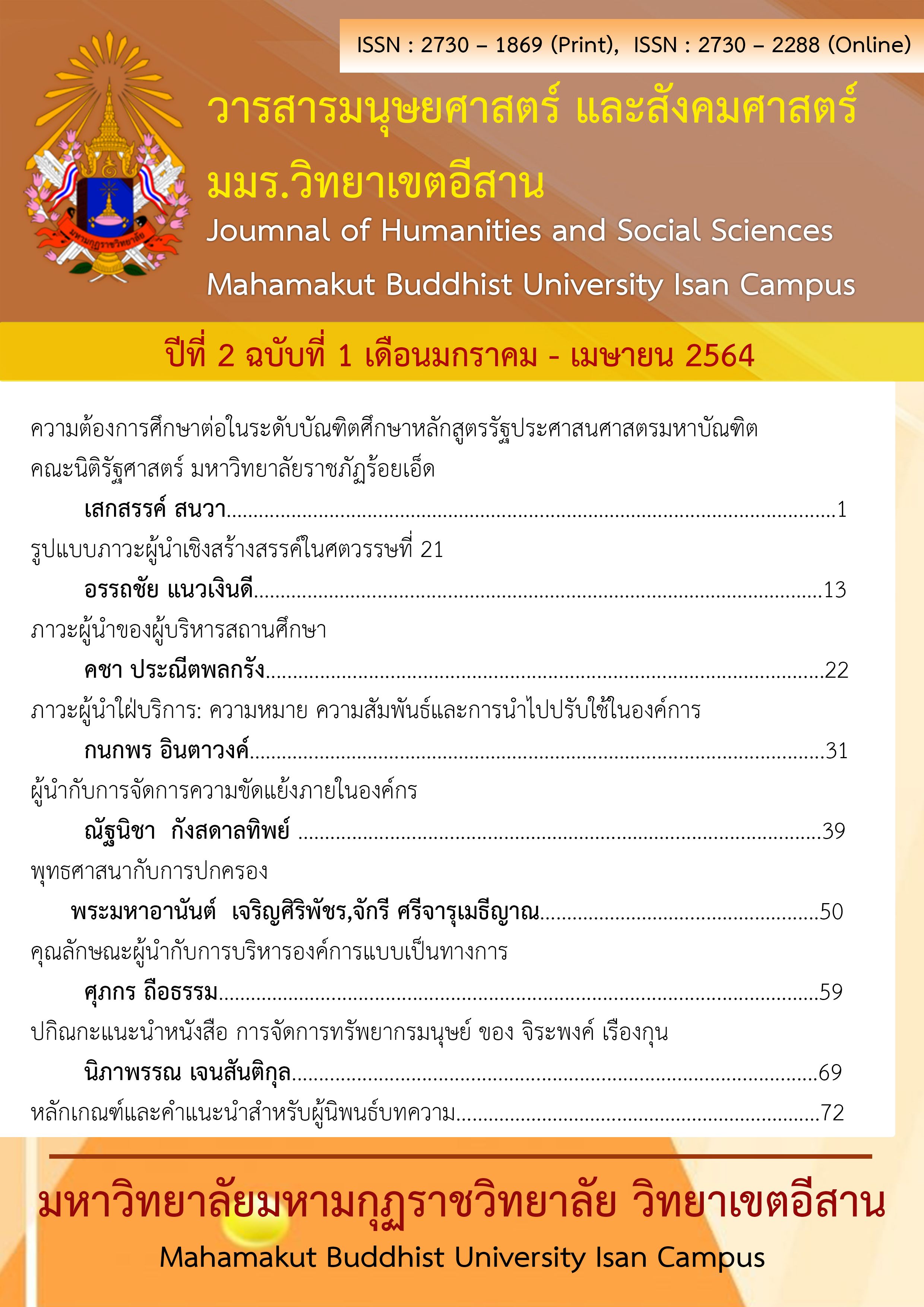Leader with Conflict Management in Organization
Keywords:
Leadership, Conflict, Conflict ManagementAbstract
This article discusses the meaning, significance, theory of conflict management. The leaders and the management of conflicts found that leaders must have a method for dealing with conflicts at an appropriate and effective level consisting of 5 methods: 1) avoidance 2) reconciliation 3) compromise 4) competition, and 5) cooperation. The authors identified three conflict situations as follows: 1) the interpersonal conflict situations, leaders can use reconciliation and compromise management methods. 2) the group conflict or organizational conflict situations, leaders can use avoidance and cooperative conflict management approach. 3) the individual conflict or group conflict or organizational conflict situations, the conflict cannot be resolved. There were arguments and refused to agree. Competitive conflict management methods should be used. Leaders play a key role in allowing couples to learn from each other and to take advantage of the conflict to reexamine and build a healthy relationship to reduce problems and find solutions to conflicts together seeking cooperation that both sides can most agree on a guideline that the conflict should be given priority.
References
ชมภูนุช ขาวผ่อง. (ม.ป.ป.). ความขัดแย้ง. [ออนไลน์] สืบค้นจาก https://sites.google.com/site/chmphunuchkhawphxng/khwam-khad-yaea. สืบค้นเมื่อ 8 ธันวาคม 2563.
ชาติชาย คงเพ็ชรดิษฐ์ และธีระวัฒน์ จันทึก. (2559). การบริหารการเปลี่ยนแปลง: บทบาทของภาวะผู้นำและการสื่อสารในองค์การ. Veridian E-Journal, Silpakorn University, 9 (1), 895-919.
ชัยเสฏฐ์ พรหมศรี. (2550). การจัดการความขัดแย้งในองค์การ. กรุงเทพฯ: เอ็กซเปอร์เน็ท.
นักรบ จุลเสวก. (2562). ความขัดแย้งภายในองค์การทางพิเศษ A ของการทางพิเศษแห่งประเทศไทย (กทพ.). บัณฑิตวิทยาลัย มหาวิทยาลัยเกษตรศาสตร์.
มิ่งขวัญ พงษ์สถิตย์. (ม.ป.ป.). การจัดการความขัดแย้งภายในองค์กร. ม.ป.ท.
ศิริมา อัศวเรชา. (2555). เอกสารประกอบการสอน รายวิชา ศท 121 การดำรงชีวิตในสังคมยุคใหม่และประชาคมอาเซียน บทที่ 10 ความแตกต่างและความขัดแย้งในสังคม. กรุงเทพฯ: สำนักวิชาศึกษาทั่วไป มหาวิทยาลัยเกษมบัณฑิต.
ศิริวรรณ มนอัตระผดุง. (2559). การจัดการความขัดแย้งในองค์กรอย่างสร้างสรรค์. วารสารวไลยอลงกรณ์ปริทัศน์, 6 (2), 193-208.
สมิต สัชฌุกร. (2552). บทบาทของผู้นำทีมในการจัดการกับความขัดแย้ง. TPA News, 151, 12-13.
สัมนา รธนิธย์. (2553). ภาวะผู้นำของผู้บริหาร (พิมพ์ครั้งที่ 2). กรุงเทพฯ: สำนักพิมพ์ข้าวฟ่างจำกัด.
สิญาธร นาคพิน และวิลาวัณย์ สมบูรณ์. (2562). การบริหารความขัดแย้งในองค์กรภาครัฐ ยุคประเทศไทย 4.0. วารสารราชภัฏสุราษฎร์ธานี. 6 (2), 21-46.
สิระยา สัมมาวาจ. (2539). การบริหารความขัดแย้ง. ภาควิชาพยาบาลศาสตร์ คณะแพทยศาสตร์ โรงพยาบาลรามาธิบดี มหาวิทยาลัยขอนแก่น.
Coser, L.A. (1957). Social Conflict and the Theory of Social Change. The British Journal of Sociology, 8 (3), 197-207.
Crouch, C. (2011). Ralf Gustav Dahrendorf 1929–2009. Proceedings of the British Academy, 172, 93–111.
Hybel, S., & Weaver, R. L. (2015). Communicating Effectively (11th ed.). New York: McGraw-Hill Education.
Karl, M. (1894). Capital Vol. III. A Critique of Political Economy: Volume Three. London: Penguin.



